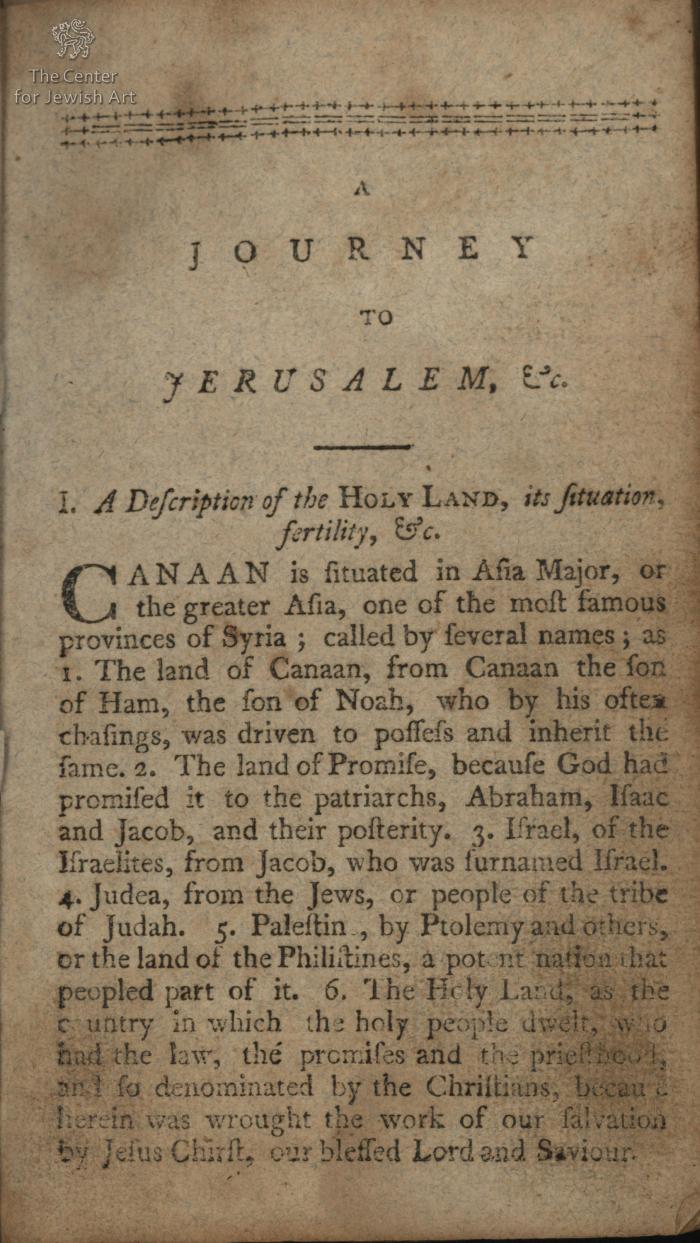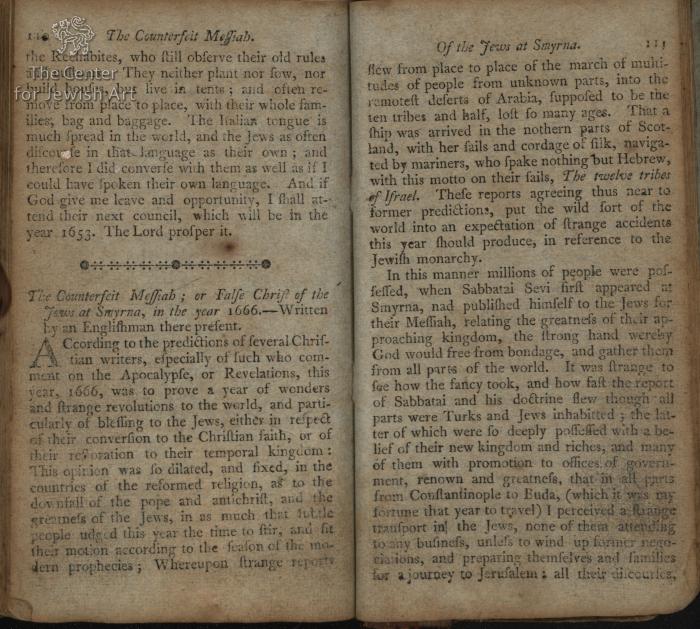Obj. ID: 40601 A Journey to Jerusalem by R. Burton, Hartford, CT, 1796

sub-set tree:
This text was prepared by William Gross:
Shabbetai Zvi was born in Smyrna in 1626, he showed early promise as a Talmudic scholar, and even more as a student and devotee of Kabbalah. More pronounced than his scholarship were his strange mystical speculations and religious ecstasies. He traveled to various cities, his strong personality and his alternately ascetic and self-indulgent behavior attracting and repelling rabbis and populace alike. He was expelled from Salonica by its rabbis for having staged a wedding service with himself as bridegroom and the Torah as bride. His erratic behavior continued. For long periods, he was a respected student and teacher of Kabbalah; at other times, he was given to messianic fantasies and bizarre acts. At one point, living in Jerusalem seeking "peace for his soul," he sought out a self-proclaimed "man of God," Nathan of Gaza, who declared Shabbetai Zvi to be the Messiah. Then Shabbetai Zvi began to act the part, as Gershom Scholem describes:
Riding around on horseback in majestic state [he] summoned a group of his followers, appointing them as apostles or representatives of the Twelve Tribes of Israel. The messianic news spread like wildfire to other communities in Palestine. First reports about Shabbetai Zvi reached Europe early in October 1665, containing detailed accounts. Much was mixed with legendary material and arrived as well in Italy, Holland, Germany and Poland. Messianic fervor took hold of communities that had no immediate experience of persecution and bloodshed as well as those which experienced such events. Repentance alternating with public maniFeztations of joy and enthusiasm was the order of the day. From many places delegations left bearing parchments signed by the leaders of the community which acknowledged him as the Messiah and king of Israel.
Not only did Shabbetai Zvi gain militant adherents in his native Turkey and in the Near East, but even in such cosmopolitan European cities as Venice, Livorno, and Amsterdam leading rabbis and sophisticated men of affairs were caught up in the messianic frenzy.
On September 15, 1666, Shabbetai Zvi, brought before the Sultan and given the choice of death or apostasy, prudently chose the latter, setting a turban on his head to signify his conversion to Islam, for which he was rewarded with the honorary title "Keeper of the Palace Gates" and a pension of 150 piasters a day. The apostasy shocked the Jewish world. Leaders and followers alike refused to believe it. Many continued to anticipate a second coming, and faith in false messiahs continued through the eighteenth century. In the vast majority of believers, revulsion and remorse set in and there was an active endeavor to erase all evidence, even mention of the pseudo-Messiah. Pages were removed from communal registers, and documents were destroyed. Few copies of the books that celebrated Shabbetai Zvi survived, and those that did have become rarities much sought after by libraries and collectors.
This is an American edition of the first English edition of this book from , Gross Family Collection NHB. 404.
An augmented version of 'A journey to Jerusalem' attributed in the Dictionary of national biography to Nathaniel Crouch, who used the pseudonyms Robert Burton, Richard Burton, and, most commonly, R.B. Includes works by Henry Timberlake, Samuel Brett, John Evelyn and Nath. Holmes. Includes: 'Memorable remarks upon the ancient and modern state of the Jewish nation', 'A strange and true account of the late travels of two English pilgrims, .. In a letter from H. T.', 'A journey to Jerusalem. .. in the year, 1669', 'A true relation of the proceedings of th Great Council of the Jews, .. By Sam. Breet', 'A brief chronology concerning the Jews, from the year of Christ, 1650, to 1666. By Nath. Homes, ..', 'The counterfeit Messiah, or false Christ of the Jews at Smyrna; in the year 1666', and 'The proceedings about the Jews in England in the year 1655'.
Nathaniel Crouch, a bookseller in London from about 1664 to about 1725, was the compiler of a large number of small books (more than forty) 'which, issued at a shilling each, had a great popularity.' They were published under the pseudonym of T.B., R. B., R. Burton, Richard Burton, and (after his death) Robert Burton. The earliest of the publications is supposed to be A Journey to Jerusalem, 1672. This was reprinted by Crouch in 1683, as part of a new work entitled Two Journeys to Jerusalem, which also contained an account of the travels of 'two English Pilgrims,' Henry Timberlake and John Burrell (first printed at London in 1603) and a relation of the Jewish Council in Hungary, by Samuel Brett (first printed at London in 1655). The book ran through many editions, all of which are now rare. I have met with titles of the edition of 1682,1685, 1892, 1730,1738, 1759, 1786, 1796.







